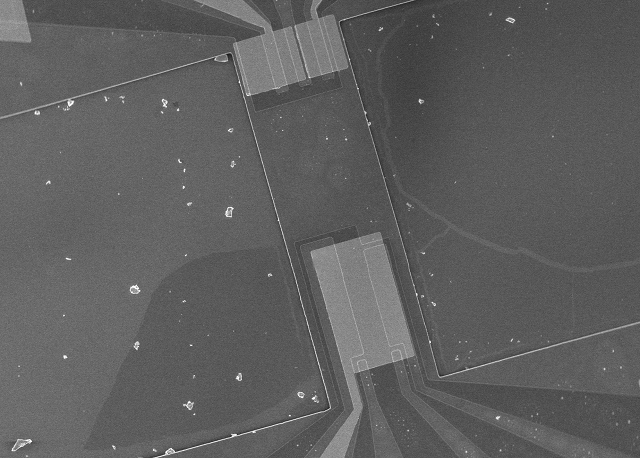
A major triumph in physics involved using photons to produce a quantum state in a mechanical oscillator that was visible to the naked eye. Mechanical oscillations are vibrations of atoms within a solid, which act as particles called phonons (since they are quantized sound waves). The control of phonons is more difficult than the control of photons; if we could control them, it would open up a whole new area of nanotechnology research, including the entanglement of mechanical systems.
While the manipulation of phonons using light has been achieved, researchers in Japan have now found a way to control mechanical vibrations using electrically induced oscillations: controlling phonons with other phonons. In a Nature Physics paper, I. Mahboob, K. Nishiguchi, H. Okomoto, and H. Yamaguchi describe the construction of an acoustic resonant cavity, where one set of vibrations sets up a second oscillation, much as certain musical notes can cause other objects to vibrate. The difference is that both sets of vibrations are in the same object (the acoustic cavity), and the secondary oscillations are tunable, so their properties can be controlled by the external electrical signal.
The acoustic resonant cavity is inspired by optical resonant cavities, in which photons form standing waves. These in turn cause atoms in a solid to vibrate, creating phonons. Adjusting the photons' properties tunes the phonons, meaning the light controls the sound. The acoustic resonant cavity works on the same principle, but uses one set of phonons to drive the creation of another set.
The phonon resonant cavity isn't a "cavity" per se. Instead, it's a single mechanical oscillator: a thin semiconductor wafer made of gallium arsenide and aluminum gallium arsenide (GaAs/AlGaAs). Gold electrodes interact with the electron gas within the wafer to make it vibrate, via what is known as a piezoelectric effect. Just as a guitar string doesn't vibrate at a single frequency (making the overtones that give the full sound), the wafer doesn't produce phonons at a single frequency either: it has a second mode of oscillation.
Unlike guitar strings, however, the relationship between the first and second phonon modes can be adjusted. By manipulating the electron gas using an external bias voltage, the frequency of both modes can be changed, as well as the strength of the coupling between them. Therefore, even though the wafer is a single object, the second phonon mode behaves as though it's a separate system that can be controlled.
Unlike pure optical resonant systems, phonons can propagate into the crystal lattice of the underlying substrate. This means by controlling the vibrations externally, properties of a larger solid can also be manipulated.
Additionally, just as two photon states can be entangled, the control of phonons should allow them to be entangled as well, which has interesting implications for quantum information studies. Many quantum computing concepts are based on entanglement, and the possibility of entangling two mechanical devices is certainly intriguing.
Nature Physics, 2012. DOI: 10.1038/nphys2277 (About DOIs).
Listing image by Photograph by courtesy of Imran Mahboob
reader comments
7